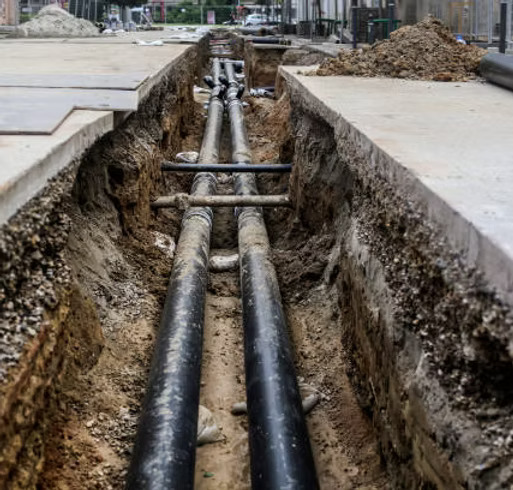Underground utility trenching is a critical component of modern infrastructure projects, including the installation of essential utilities like water, electricity, gas, telecommunications, and sewage systems. As urban populations grow and the demand for these services increases, the need for effective underground utility trenching techniques has become more pronounced.
Trenching is a technique used to create a narrow, long excavation in the ground to install or repair utilities. This process is often part of large-scale construction projects where the work must be done efficiently, safely, and with minimal disruption to the surrounding area. The technology, tools, and techniques used for underground utility trenching have evolved over the years, providing contractors with better equipment and methods to improve project timelines and reduce costs.
This article will delve into the various techniques and tools used in underground utility trenching, exploring how these innovations are shaping modern infrastructure development.
Key Techniques in Underground Utility Trenching
There are several methods and techniques employed in underground utility trenching, each designed to meet specific needs depending on factors like soil type, trench depth, and utility type. Below are the most common techniques used:
1. Open-Cut Trenching
Open-cut trenching is the most traditional and widely used method for underground utility trenching. This technique involves the complete removal of soil from the trench area, which is typically dug with a backhoe or trenching machine. Once the trench is excavated, utilities such as pipes, cables, or wires are placed into the trench before the soil is backfilled and compacted.
Open-cut trenching is often used when the soil is soft or when the utilities need to be placed at a considerable depth. The method is highly effective for projects that involve installing large-scale utilities like sewer lines, electrical cables, or water mains. However, open-cut trenching can be disruptive, requiring road closures or disruption to other surface-level structures, especially in urban settings.
2. Trenchless Technology
In cases where minimal surface disruption is required, trenchless technology has emerged as a solution. This method allows for the installation of utilities without digging a full trench. One common trenchless technique is horizontal directional drilling (HDD), where a drilling machine creates a horizontal borehole for the utility to pass through.
HDD and other trenchless methods are ideal for crossing under existing infrastructure, such as roads, railways, or rivers, where digging a trench would be either impractical or damaging. Trenchless techniques are often used for smaller installations like telecommunications lines, gas pipes, or fiber-optic cables. They require specialized equipment but can significantly reduce costs and time for installations compared to traditional open-cut trenching.
3. Plowing
Plowing is another method of underground utility trenching, which involves using a plow to push a utility cable or pipe into the ground without creating a large excavation. The plow creates a narrow, shallow trench and leaves the surrounding earth relatively undisturbed.
This technique is commonly used for laying cables or pipes in less densely populated areas or rural locations. It’s particularly effective for applications where only small utilities, such as electrical lines or fiber-optic cables, need to be installed. The speed and minimal surface disruption of plowing make it a preferred method for projects with time-sensitive deadlines.
4. Shoring and Shielding
In situations where trenching occurs at great depths or in areas with loose or unstable soil, shoring and shielding are essential safety techniques. Shoring involves the use of support structures like timber, steel, or hydraulic systems to prevent the sides of the trench from collapsing. This is particularly important when workers are operating within deep trenches, as cave-ins pose significant risks.
Shielding, on the other hand, involves the installation of protective barriers or trench boxes around the workers to provide a safe working environment. These barriers are usually made of steel and designed to protect workers from falling debris or soil. Both shoring and shielding are required by safety regulations to ensure that underground utility trenching is performed safely in hazardous conditions.
Tools Used in Underground Utility Trenching
Various tools are used to perform underground utility trenching efficiently and safely. Below are some of the most essential tools involved in the process:
1. Trenching Machines
Trenching machines are the workhorses of underground utility trenching. These machines, which come in a variety of sizes and configurations, are used to dig the trench with precision and speed. Trenching machines typically consist of a large rotating chain or belt with teeth designed to break up and remove soil.
There are several types of trenching machines, including chain trenchers, wheel trenchers, and micro trenchers. The type of trencher chosen depends on the project’s requirements, including the depth and width of the trench, as well as the type of material being excavated. Larger trenchers are used for deeper, wider trenches, while smaller trenchers are ideal for shallow installations or projects requiring smaller, more precise trenches.
2. Backhoes
Backhoes are versatile digging machines commonly used in underground utility trenching projects. They are equipped with a shovel-like bucket at the end of a long arm that allows the operator to scoop out soil and debris from the trench. Backhoes are used for both digging and backfilling, and their maneuverability makes them a popular choice for work in more confined or urban areas.
Backhoes can handle a variety of soil types and depths, and their adjustable arms make them suitable for smaller or more intricate trenching projects.
3. Compactors
Once a trench is dug and utilities are placed, the next step is often backfilling and compacting the soil to ensure proper settling and prevent future sinkholes. Compactors, such as vibratory rollers or plate compactors, are used to compact the soil and ensure that the trench is filled tightly around the utilities.
Proper compaction is essential to maintaining the integrity of the trench and preventing erosion or settling over time. It also helps ensure the safety of nearby infrastructure and minimizes future repair costs.
4. Plowing Equipment
For plowing methods, a plow blade is typically used to cut a narrow trench in the ground. The plow is attached to a tractor or excavator, and the blade is lowered into the ground to push utilities into the soil. The plow works by displacing the soil rather than digging it up, allowing utilities to be installed with minimal surface disruption.
The plowing equipment used can vary depending on the specific utility being installed. For example, a cable plow may be used to lay electrical cables, while a pipe plow can be used for gas or water pipelines.
Challenges and Considerations in Underground Utility Trenching
Despite the advancements in tools and techniques, underground utility trenching does come with its own set of challenges. For example, working around existing infrastructure, managing environmental impacts, and ensuring the safety of workers are all critical considerations. Additionally, weather conditions, soil composition, and accessibility issues can influence the choice of method or tools.
Advanced planning, careful site analysis, and the selection of the right tools and techniques are essential for ensuring a successful trenching project. Coordination with other construction tasks is also important to ensure that the installation of utilities doesn’t interfere with other aspects of the project, such as roadwork or landscaping.
Conclusion
Underground utility trenching is an essential technique for modern infrastructure development, and the methods and tools used in the process continue to evolve. Whether it’s using traditional open-cut trenching, trenchless technologies, or plowing methods, each technique offers distinct advantages depending on the project’s requirements. The proper use of specialized tools like trenchers, backhoes, and compactors helps to streamline the process, making it more efficient and safe.






























